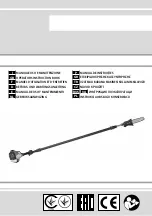
GB | 33
g)
Support large panels to minimise the risk of
saw blade pinching and kickback.
Large pan
-
els tend to sag under their own weight.
Support(s)
must be placed under all portions of the panel
overhanging the table top.
h)
Use extra caution when cutting a workpiece
that is twisted, knotted, warped or does not
have a straight edge to guide it with a mitre
gauge or along the fence.
A warped, knotted,
or twisted workpiece is unstable and causes mis
-
alignment of the kerf with the saw blade, binding
and kickback.
i)
Never cut more than one workpiece, stacked
vertically or horizontally.
The saw blade could
pick up one or more pieces and cause kickback.
j) When restarting the saw with the saw blade
in the workpiece, centre the saw blade in the
kerf so that the saw teeth are not engaged in
the material.
If the saw blade binds, it may lift up
the workpiece and cause kickback when the saw
is restarted.
k)
Keep saw blades clean, sharp, and with suf
-
ficient set.
Never use warped saw blades or
saw blades with cracked or broken teeth.
Sharp and properly set saw blades minimise bind
-
ing, stalling and kickback.
Table saw operating procedure warnings
a)
Turn off the table saw and disconnect the
power cord when removing the table insert,
changing the saw blade or making adjust
-
ments to the riving knife, antikickback device
or saw blade guard, and when the machine is
left unattended.
Precautionary measures will
avoid accidents.
b)
Never leave the table saw running unattend
-
ed.
Turn it off and don’t leave the tool until it
comes to a complete stop.
An unattended run-
ning saw is an uncontrolled hazard.
c)
Locate the table saw in a well-lit and level area
where you can maintain good footing and bal
-
ance.
It should be installed in an area that pro
-
vides enough room to easily handle the size
of your workpiece.
Cramped, dark areas, and
uneven slippery floors invite accidents.
d)
Frequently clean and remove sawdust from
under the saw table and/or the dust collection
device.
Accumulated sawdust is combustible and
may self-ignite.
e)
The table saw must be secured.
A table saw
that is not properly secured may move or tip over.
f)
Remove tools, wood scraps, etc. from the ta
-
ble before the table saw is turned on.
Distrac-
tion or a potential jam can be dangerous.
j) Feed workpiece at an even pace.
Do not bend
or twist the workpiece.
If jamming occurs, turn
the tool off immediately, unplug the tool then
clear the jam.
Jamming the saw blade by the
workpiece can cause kickback or stall the motor.
k)
Do not remove pieces of cut-off material while
the saw is running.
The material may become
trapped between the fence or inside the saw blade
guard and the saw blade pulling your fingers into
the saw blade.
Turn the saw off and wait until the
saw blade stops before removing material.
l)
Use an auxiliary fence in contact with the ta
-
ble top when ripping workpieces less than 2
mm thick.
A thin workpiece may wedge under the
rip fence and create a kickback.
Kickback causes and related
warnings
Kickback is a sudden reaction of the workpiece due
to a pinched, jammed saw blade or misaligned line of
cut in the workpiece with respect to the saw blade or
when a part of the workpiece binds between the saw
blade and the rip fence or other fixed object.
Most frequently during kickback, the workpiece is lift
-
ed from the table by the rear portion of the saw blade
and is propelled towards the operator.
Kickback is the result of saw misuse and/or incorrect
operating procedures or conditions a
nd can be avoid-
ed by taking proper precautions as given below.
a)
Never stand directly in line with the saw blade.
Always position your body on the same side of
the saw blade as the fence.
Kickback may pro
-
pel the workpiece at high velocity towards anyone
standing in front and in line with the saw blade.
b)
Never reach over or in back of the saw blade
to pull or to support the workpiece.
Accidental
contact with the saw blade may occur or kickback
may drag your fingers into the saw blade.
c)
Never hold and press the workpiece that is be
-
ing cut off against the rotating saw blade.
Press-
ing the workpiece being cut off against the saw
blade will create a binding condition and kickback.
d)
Align the fence to be parallel with the saw
blade.
A misaligned fence will pinch the work
-
piece against the saw blade and create kickback.
e)
Use a featherboard to guide the workpiece
against the table and fence when making non-
through cuts such as rabbeting, dadoing or
resawing cuts.
A featherboard helps to control
the workpiece in the event of a kickback.
f)
Use extra caution when making a cut into
blind areas of assembled workpieces.
The
protruding saw blade may cut objects that can
cause kickback.
Summary of Contents for MPSCST255MM2
Page 2: ......
Page 7: ...7 1 2 3 4 5 6 7 8 9 10 11 12 13 A B C D E F G H I J K L 28 ...
Page 44: ...44 ...
Page 46: ...46 ...
Page 48: ...Cet appareil ses accessoires piles et cordons se recyclent ...
















































